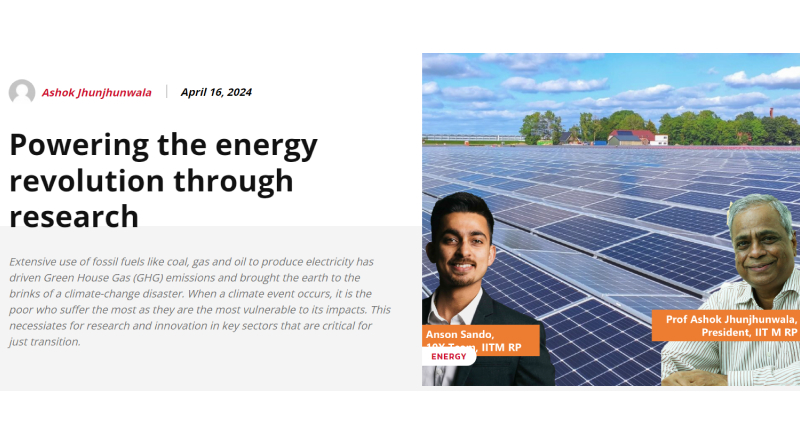Ashok Jhunjhunwala, IIT Madras and Anson Sando, IIT Madras Research Park
April 17, 2024: Extensive use of fossil fuels, like coal, gas and oil directly to produce electricity have driven Green House Gas (GHG) emissions in the world to new heights and brought the earth to the brinks of a climate-change disaster. When a climate change event occurs, it is the poor who suffer the most as they are the most
vulnerable to its impacts; as India has a large population of low-income people, they are also amongst the worst affected. Every country has to do its utmost to stop using fossil fuels and move towards renewable sources of energy. As the cost of the electricity produced from solar PV dropped to ₹2 per kWh and lower than that of coal
based electricity, India has made significant progress in deploying solar, as seen from the chart. Yet, India imports most of the solar panels it deploys from China. There is an urgent need to change this.
The manufacturing of Crystalline Silicon solar PV panels, which constitutes over 97% of global production today involves four steps. The first involves production of polysilicon. China’s capacity here is almost twice that of the worlds-demand; it would sell at any price, making polysilicon manufacturing anywhere else unviable. The
second step is in making wafers and crystals using polysilicon. China’s manufacturing capacity just about matches current demand; as the demand grows, a play is possible here. The third step is manufacturing of solar cells using the crystals and the final step is making of the solar panels. Making of Silicon solar-cells is an established technology, involving high investment. Today few large companies in India are setting this up. It would however still be somewhat difficult to compete with Chinese companies without protection. The final process of Solar panel
manufacturing involves minimal technology and has a low value-add; some fifty odd solar panel manufacturers have emerged in India over the last few years. If China does not dump panels, they would be able to compete and manufacture for India, as well as look at exports.
It is the manufacturing of solar crystals and wafers, which allows some play. Even though the process and the manufacturing set-up is well known, industrial practice requires manufacturers to develop unique design of crystal puller internals known as the hot-zone, an optimal process for the hot-zone, and the complementary process
control algorithm necessary to grow crystals. This is accomplished periodically on the present technology platform. Moreover, future technologies under development, such as continuous Czochralski and Magnetic Czochralski that improve both quality and performance can also be implemented on the present manufacturing platform.
This would enable differentiated manufacturers to reduce costs. RSOLEC has been established at Chennai recently to take up this challenge and manufacture Solar crystals and wafers. Led by some highly experienced professionals in India, it has established a subject matter expert council and an advisory council with very prominent technology-leaders across the world, with an aim to optimise the hot-zone design, process, and control scheme. The objective would be to make solar PV crystals and wafers at a cost less than what the Chinese companies incur, so that
one may theoretically supply it even to the Chinese manufacturers of solar-cells. Only with superior technology, design, process, and control schemes, one would be able to compete in the world. The company is in the process of setting up the plant in near-future and has tied up with IITM Research Park for Research and Development.
While it is the Silicon solar-PV technology that is primarily used for solar power generation all over the world, there has been a lone company in the United States, First Solar, which has kept the flag flying with an alternate technology to manufacture and deploy Cadmium Telluride (CdTe) based solar panels. Early work on this technology was carried out by an IITM alumnus in the United States. First Solar advanced the technology and started making panels, which could compete with the Silicon PV panels, both in terms of costs as well as the percentage of solar irradiation it captures (called energy efficiency of the solar panels). With increasing R&D to enhance energy efficiency of Silicon Solar-PV panels and Chinese manufacturers dominating the market and reducing costs, it is often believed that CdTe panels would not be able to compete. However, CdTe does capture more of sunlight during mornings and evenings (low sunlight hours), and works better at higher temperatures, typically the case in tropical countries like India’s with lower degradation in efficiency over the years; the net result is that CdTe solar panels over its lifetime provides as much if not higher energy as compared to that from the Silicon based solar PV panels. Recognising this, India did woo First Solar to set up a panel manufacturing plant in India. First Solar did do so and started production in 2023 in Chennai. It has set up its R&D at IITM Research Park and is now collaborating with Indian researchers to enhance its technology over time.
With RSOLEC and First Solar, we have two flag bearers that would help India to compete with China in terms of technology for solar PV, especially as it aims to use this to enhance its power generation capacity from the current value of 73.3 GW to 500 GW over the next decade or so. At the same time, India needs to pursue aggressive R&D in Perovskite, the emerging and the next generation solar PV technology, particularly for use as a second layer over Silicon or CdTe panel to further enhance its energy efficiency.
Solar PV is one of the most important technologies for India as it takes on the rising threats of climate change. While deployment using imports is welcome, India’s large demand makes it imperative to pursue its own R&D and technology. IITM Research Park recognises this crucial role and through its 10X program aims to develop
commercially viable technologies in this arduous fight against climate change, striving to keep India in leading this charge ahead.
Publication: Industrial Economist
Read more by clicking on the link to the featured article below:
![]()


